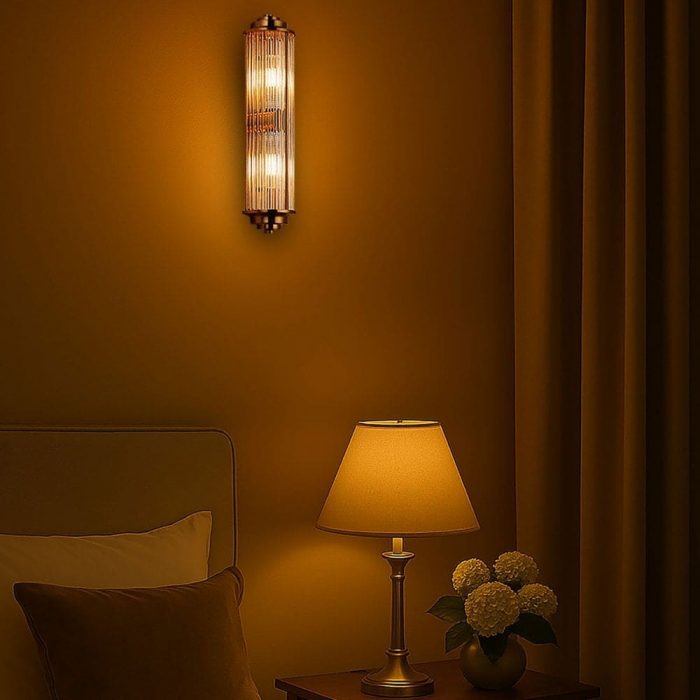
Lighting can transform any space, and when you achieve the perfect combination of light and shadow, you can create an atmosphere that feels both cinematic and dramatic. Whether designing a home cinema room, a moody living space or a stylish office, dramatic lighting is a game-changer. But how do you bring that stunning, cinematic effect into your space?
In this blog, we’ll explore key techniques and lighting fixtures to help you achieve dramatic, cinematic lighting in your home. From dark pendant lights to dimmable light bulbs, we’ll break down the best lighting methods and fixtures to turn your space into a scene straight out of a film.
Table of contents:
How do I create dramatic lighting in a dark room?
Creating dramatic lighting in a dark room relies on balancing the light and shadow. The key is not to over-illuminate the space but to use lighting to highlight features and create mood. Here are a few ways you can achieve that effect:
- Use of layered lighting: Combining ambient, task, and accent lighting can add depth and character. Consider using ambient floor lamps and ceiling spotlights to provide a soft base layer of light. In contrast, accent lights, like dimmable table lamps, can focus on specific areas, adding drama.
- Contrasting light levels: Contrast is crucial when creating dramatic lighting. Use bright, focused light in certain areas while leaving others in shadow. Dark pendant lights, for example, are perfect for adding that contrast. Their deep hues and bold designs can direct attention to specific areas in the room while leaving other parts in near darkness, increasing the overall drama.
- Adjustable lighting: Dimmer switches are invaluable when creating a cinematic feel. By using dimmable light bulbs, you have full control over the intensity of the light, allowing you to adjust the lighting as the room’s mood changes creating a more intense lighting effect when needed and softening it when a more subtle atmosphere is desired.
With these techniques, you can turn a dark room into an intriguing, moody space with dramatic lighting that evokes a cinematic feel.
What are the best lighting techniques for shadowy spaces?
Lighting shadowy spaces can be tricky. However, with the right approach, you can turn shadows into an important part of the room’s design. Here are a few techniques that can help you do that:
- Uplighting and downlighting: Uplighting and downlighting are excellent methods for creating cinematic effects in shadowy spaces. Uplighting, which involves directing light upward (typically through a floor lamp or a wall-mounted fixture), can emphasise architectural features or create dramatic shadows on the ceiling. Downlighting allows you to focus light downward, highlighting specific areas while leaving the surrounding space in shadow. Both lighting techniques work exceptionally well when used together, helping to define the space and create a striking and cinematic atmosphere.
- Spotlights and task lighting: Ceiling spotlights can be used strategically to highlight key features like artwork, sculptures, or even furniture. When paired with dimmable light bulbs, you can fine-tune the intensity of the spotlight to suit the desired effect. Spotlights help draw attention to particular elements of the room while keeping the rest of the space dark and mysterious.
- Directional lighting: Another technique for illuminating shadowy spaces is to use light that directs the eye, which can be done with adjustable table lamps or floor lamps. By angling the light source towards certain objects, you can create pools of light that naturally enhance the shadowy vibe of the room.
For shadowy spaces, the goal is to play with light and dark contrasts. Use lighting to emphasise the room’s unique features while maintaining a moody, cinematic atmosphere.
How do I use contrast to create dramatic lighting?
Contrast is one of the most powerful tools for creating dramatic lighting. You can create depth, interest, and mood by highlighting certain areas of a room while leaving others dark. Here’s how you can use contrast effectively:
- Highlighting key elements: Create a cinematic look by choosing key elements of your room to highlight, such as furniture, artwork, or an architectural feature. Dark pendant lights are perfect for this, providing focused light while casting shadows on the surrounding area. They make the highlighted object stand out while the rest of the room remains in soft, atmospheric darkness.
- Mixing light fixtures: Incorporating different light sources with varying intensities creates contrast within the space. For example, soft ambient light from a floor lamp can contrast beautifully with a ceiling spotlight’s sharp, focused light. This mix of lighting types—whether bright or subtle—will add complexity to the room’s lighting design, giving it a cinematic flair.
- Utilising colour temperature: The temperature of the light plays a huge role in contrast. Cooler lights (around 5000K) make spaces feel more sterile and modern. In contrast, warmer lights (around 2700K) evoke a cosy, nostalgic atmosphere. A cinematic effect can be achieved by layering colour temperatures and lighting areas. For example, use dimmable light bulbs with a warm setting in one area and cooler spotlights elsewhere to create a dynamic visual effect.
You can achieve the dramatic, cinematic atmosphere you’re looking for by playing with contrast in your lighting. Don’t be afraid to experiment with different light fixtures and temperatures to find the best balance for your space.
Create cinema-worthy lighting with Dusk Lights
Lighting plays an essential role in creating atmosphere and mood. Whether you want to transform a dark room into a cinematic experience or highlight key features of your space with dramatic effects, understanding the power of lighting techniques is crucial.
At Dusk Lights, we stock various fixtures designed to create a dramatic atmosphere, from spotlights to floor lamps.
With the right lighting fixtures, your room can go from ordinary to extraordinary — adding a touch of elegance and intrigue to any space. Browse our selection today and create cinema-worthy lighting in your home.
Related articles:
